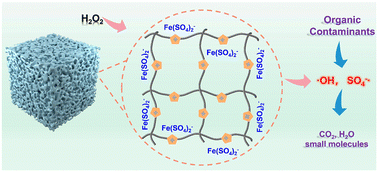Efficient degradation of organic contaminants via a novel iron-based poly(ionic liquid)/polydopamine composite as the heterogeneous Fenton catalyst†
Abstract
Poly(ionic liquid)s (PILs) are promising candidates for constructing highly efficient and stable heterogeneous Fenton catalysts due to their tunable chemical structure, abundant active sites, and universal compatibility with different substances. Herein, an iron-based PIL/polydopamine (PDA) composite (PDVIm-Fe/PDA) is successfully synthesized for organic contaminant degradation. The high iron content, formation of ˙OH and SO4˙− radicals and mesoporous structure of the composite allow for ∼99% malachite green (MG) degradation efficiency with the degradation rate constant of 1.95 min−1 and the as-defined catalytic degradation rate of 0.79 g(MG) g(PDVIm-Fe/PDA)−1 min−1, showing much higher activity than most of the reported heterogeneous catalysts. The composite can be used in a wide pH range and recycled seven times without an obvious catalytic performance decrease, and it can also be applied to the degradation of other organic pollutants. The excellent stability and versatility make PDVIm-Fe/PDA an efficient heterogeneous Fenton catalyst for practical applications in wastewater treatment.

- This article is part of the themed collection: Nanomaterial applications in water


 Please wait while we load your content...
Please wait while we load your content...